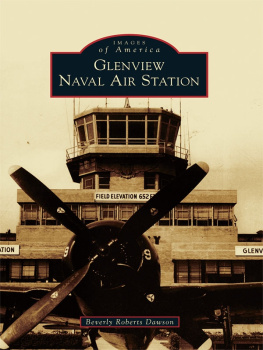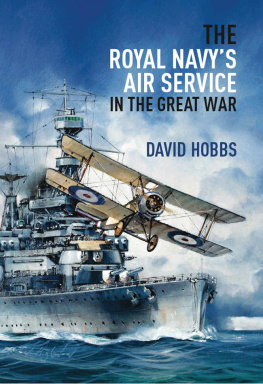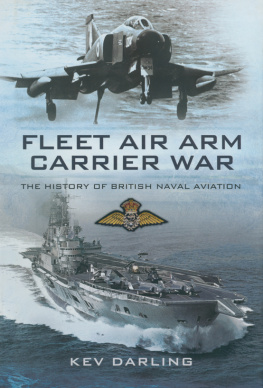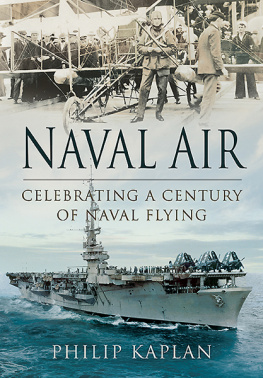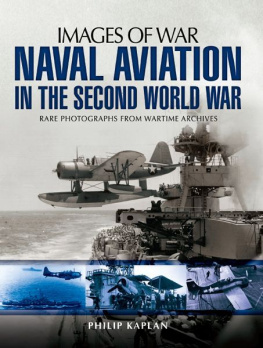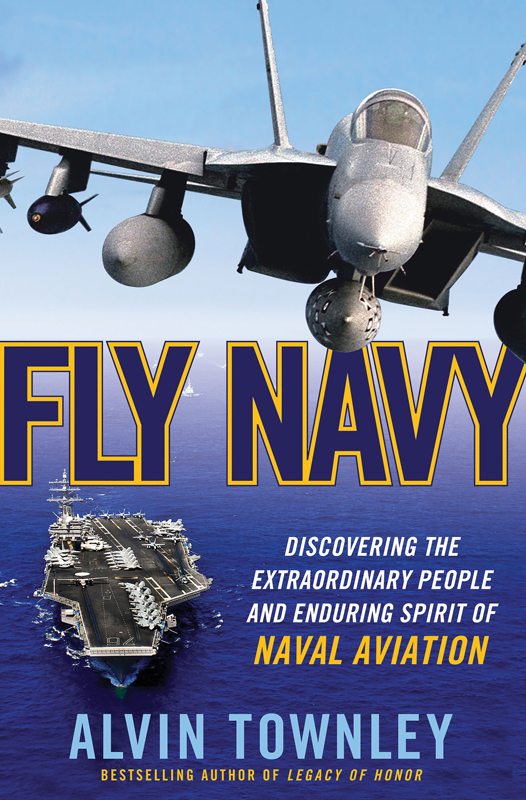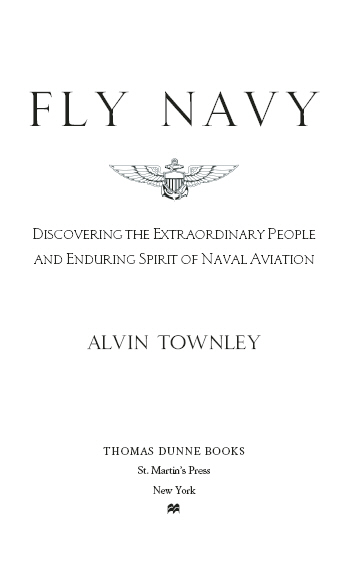
To those who have served America so honorably during the first one hundred years of naval aviation, and to those who will carry this legacy into its second century
CONTENTS
INTRODUCTION
I STILL REMEMBER FIRST WATCHING the phantom figures of crewmen moving through the ghostly steam of an aircraft carriers catapult, and seeing the silhouettes of F-14 Tomcats taxiing slowly across the windswept deck of the USS Enterprise . The image of wings unfolding, crewmen locking aircraft into position, and jets straining against blast deflectors will never leave me. Ill always remember that sense of anticipation, and Ill never forget the raw thrill that shot through me when I first saw those big fighters thunder into a dawn sky.
Like many people, my introduction to naval aviation came with that opening scene of Top Gun . When those Tomcats leapt off the deck, they left an entire nation enchanted by the individuals, aircraft, and ships that comprise the high-stakes world of naval aviation. The power of jet engines and the sheer excitement of flight operations captivated us. Millions of Americans have now seen the film; we love its characters and know the lines by heart. Its heroesMaverick, Goose, Viper, Icemanhave come to represent the camaraderie, adventure, and greatness for which we all hunger. We think that the people on carrier flight decks just might be privy to a secret that the rest of us were never told, and in truth, some part of us longs to join their fraternity, be part of that great undertaking, and perhaps strap into a cockpit ourselves.
Naval aviation has fascinated me since the first time I watched the film years ago, but I am not of naval aviation. Ive never worn an aviators wings of gold. Ive never raced across a flight deck to ready a jet for launch, nor have I endured a long deployment that carried me oceans away from home. My place lies with other civilians, forever observers to one of the worlds greatest pageants.
Before watching Top Gun , I had little personal knowledge of carrier aviation. Mine was not a military family. I didnt know the nineteen-year-olds who worked the flight decks, the veteran leaders who trained the crews, or the aviators who flew the missions. Consequently, I never understood the real people who comprised the extraordinary team that sends aircraft screaming off a flight deck. But even Top Gun didnt reveal the entire story.
I will always appreciate the 1986 blockbuster for being what it isa great and inspiring film. Over time, however, Ive come to recognize what it is not. The film had left me with the impression that naval aviators were polished demigods who won glory for themselves. I assumed that deck crews had insignificant roles, and I viewed aviation as a one-on-one sport, with the fictitious Top Gun trophy as its prize. That woefully inaccurate perception remained unchanged for many years, but then I finally stood on a carriers flight deck and saw for myself what transpired on its four acres. In those unforgettable minutes, my view of naval aviation changed forever.
* * *
Three F/A-18E Super Hornets flew through a clear Pacific sky just off the Hawaiian Islands, toward the homeward-bound aircraft carrier USS Nimitz . As they roared overhead, just off the carriers starboard (right) side, my friend Lee Amerines jet gracefully peeled away from the formation and crossed over the unplowed sea before the ships bow. He flew Aircraft 212 down the length of the flight deck, one mile off the port side. Nearly parallel with the decks end, the twenty-eight-year-old lieutenant banked into another 180 degree turn that placed him squarely behind the carrier, three hundred and fifty feet above her churning wake. He continued his bank until he lined up with the landing strip that ran right to left at a slight angle across the ships deck.
From Lees viewpoint, the carrier seemed like an impossibly small stripe of gray in an endless sea of blue. He would have to land his Rhino (as Super Hornets are also known) on this short, narrow, gently pitching runway. He had to set his tailhook onto a 150-foot-long by ten-foot-wide portion of that runway so it could catch one of the four arresting cables that would bring him to a halt. Really, he was expected to catch the optimal number three wire. That gave him a precise fifty-foot by ten-foot slice of deck to target with his steel tailhook, which hung from the jets tail, fifty feet behind the cockpit. Aircraft and hook were moving at more than 140 miles per hour, and Lee had to lay them into that tiny groove.
Even after landing on the Nimitz almost daily for six straight months during his deployment to the Arabian Sea, Lees muscles still tensed as he settled his plane onto the glide slope; the rapidly approaching deck before him consumed his entire focus. Many flight deck veterans call carrier landings controlled crashes for a reason, and almost nothing presents a greater challenge to a pilot. Naval aviators dont gently settle their planes onto the landing strip after a long straight approach; they are only lined up with the centerline behind the boat for fifteen seconds. They effectively slam their planes onto a small, crowded deck, mere feet from the crew and parked aircraft, hoping to catch the wire. At least Lee was making this landing on a calm, sunny day. The dark of night or heaving decks that can rise and fall more than twenty feet will drive aviators pulse rates even higher.
I was Lees guest for the weekend and from my vantage point near the rear of the flight deck, I watched a green light flash on the Landing Signal Officers platform indicating that the deck was clear for landing. From that crowded platform on the carriers aft corner, a team of pilots responsible for safely landing aircraft watched the Super Hornet approach, ready to help if needed. Lee continued descending toward the deck, using the jets expansive flaps and stabilators to supply lift as he maintained 140 miles per houra relatively slow airspeed that would still carry him over the deck so fast that ship, deck markings, aircraft, and crew would all pass by in a blur. Landing gear down and trailing two curling brown plumes of exhaust, Lee rapidly closed the remaining distance to the ship.
The engines of Aircraft 212 roared over the stern and Lees wheels squeaked onto the steel deck. His wingtips cleared the line of planes and crew next to me by ten feet; he had no margin for error. In a movement too quick for me to see, the tailhook caught its target: the third of four arresting wires. The thick steel cable began spooling out behind the thundering plane. Lee had pushed his throttle forward in case his hook missed the wire and he had to get his forty-four-thousand-pound jet airborne before he shot over the end of the angled flight deck, which he reached in just two seconds. His afterburners flared and his two turbofan engines blasted the deck with heat, noise, and the unmistakable perfume of jet exhaust.
His hook held its grip and the black line of arresting cable pulled taught, slowing the charging jet. Beneath the deck, a powerful hydraulic system unleashed a deafening hiss as it used oil fluid pressure and a series of levers to exert just the right amount of tension on the wireenough to stop the Super Hornet within three hundred feet, but not enough to rip the tailhook away from its body. Less than three seconds after his hook caught the wire, Lees jet came to a halt just yards shy of the decks end. With his engines whining at idle, he raised his hook and let out a long sigh of relief: safe recovery, successful trap. The cable retreated to its original position to receive the next jet, and a yellow-shirted plane director caught Lees attention and motioned him forward and out of the way.



